Business Environment Report: Analysis of Primark's Operations
VerifiedAdded on 2019/12/18
|24
|6027
|233
Report
AI Summary
This report provides a comprehensive analysis of Primark's business environment. Task 1 explores Primark's purpose, stakeholder objectives (internal and external), and responsibilities, including CSR. Task 2 examines the economic systems in various countries, the impact of fiscal and monetary policies, and competition policies on Primark. Task 3 delves into market structures, pricing and output decisions, and the influence of market forces, with diagrams. It also assesses how business and cultural environments shape organizational behavior. Finally, Task 4 discusses the significance of international trade, the impact of global factors, and the policies of the European Union on UK businesses, particularly Primark. The report integrates relevant theories and examples to provide a thorough understanding of the business environment and its impact on a major retail organization.
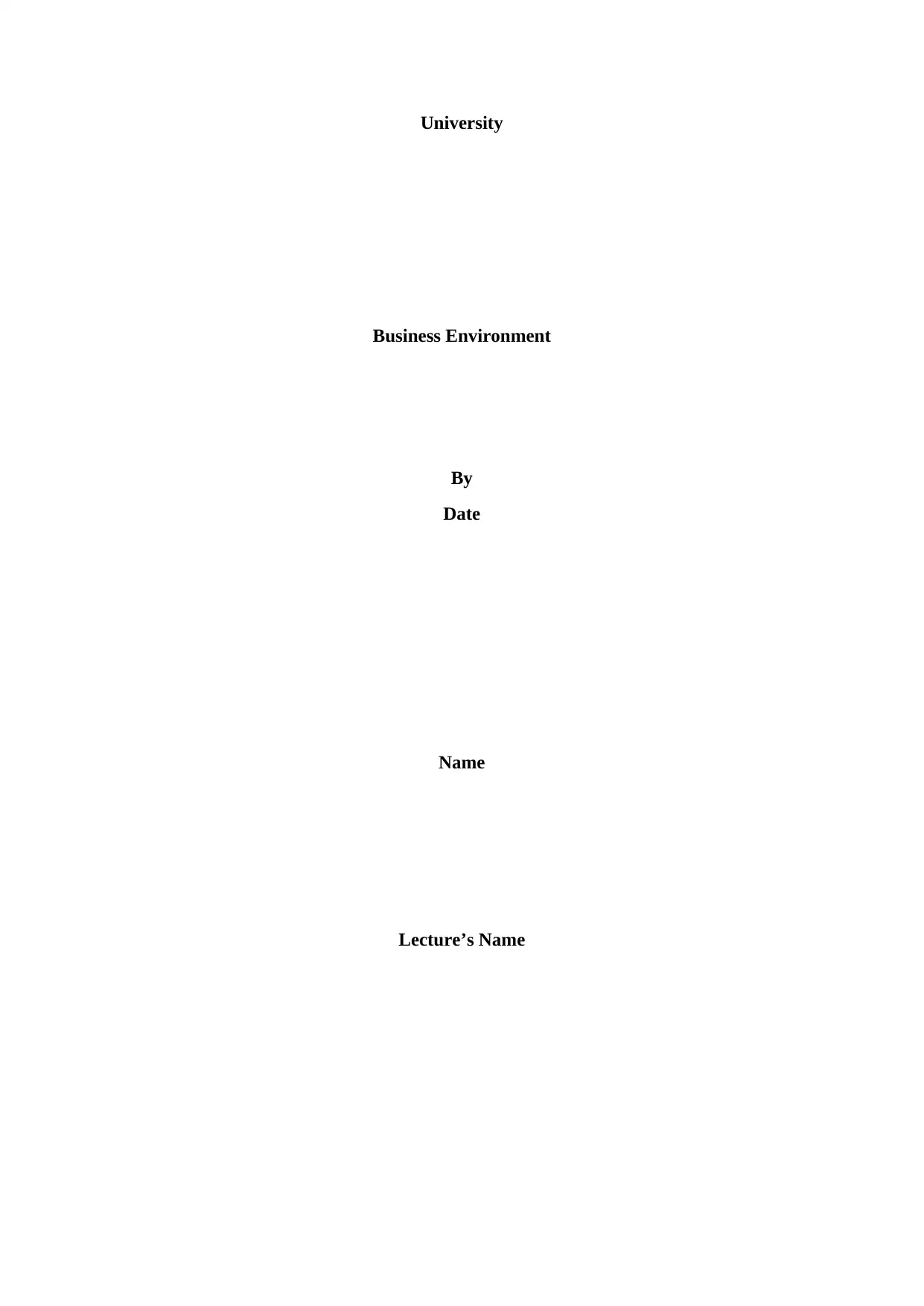
University
Business Environment
By
Date
Name
Lecture’s Name
Business Environment
By
Date
Name
Lecture’s Name
Paraphrase This Document
Need a fresh take? Get an instant paraphrase of this document with our AI Paraphraser
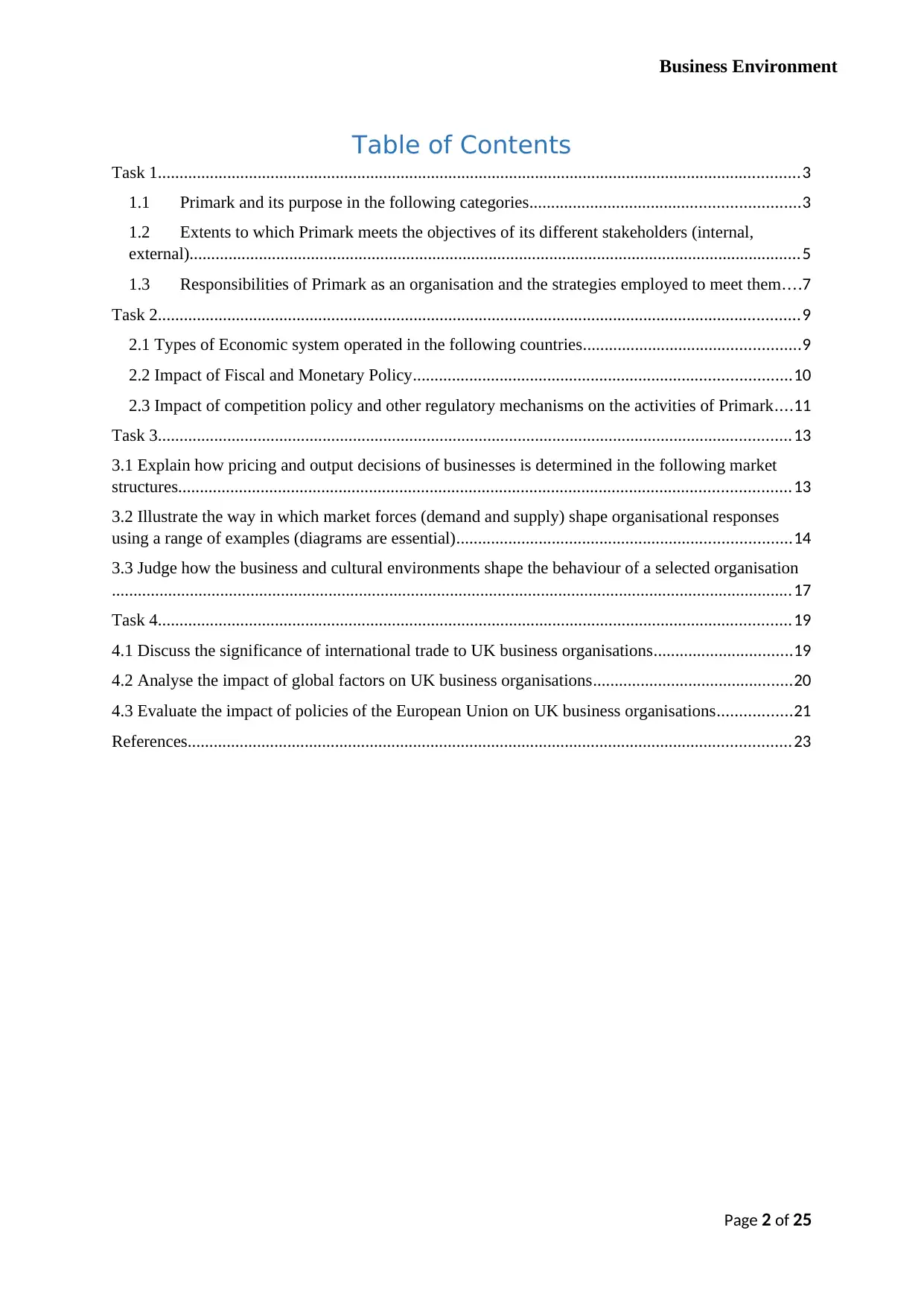
Business Environment
Table of Contents
Task 1....................................................................................................................................................3
1.1 Primark and its purpose in the following categories..............................................................3
1.2 Extents to which Primark meets the objectives of its different stakeholders (internal,
external).............................................................................................................................................5
1.3 Responsibilities of Primark as an organisation and the strategies employed to meet them....7
Task 2....................................................................................................................................................9
2.1 Types of Economic system operated in the following countries..................................................9
2.2 Impact of Fiscal and Monetary Policy.......................................................................................10
2.3 Impact of competition policy and other regulatory mechanisms on the activities of Primark....11
Task 3..................................................................................................................................................13
3.1 Explain how pricing and output decisions of businesses is determined in the following market
structures.............................................................................................................................................13
3.2 Illustrate the way in which market forces (demand and supply) shape organisational responses
using a range of examples (diagrams are essential).............................................................................14
3.3 Judge how the business and cultural environments shape the behaviour of a selected organisation
.............................................................................................................................................................17
Task 4..................................................................................................................................................19
4.1 Discuss the significance of international trade to UK business organisations................................19
4.2 Analyse the impact of global factors on UK business organisations..............................................20
4.3 Evaluate the impact of policies of the European Union on UK business organisations.................21
References...........................................................................................................................................23
Page 2 of 25
Table of Contents
Task 1....................................................................................................................................................3
1.1 Primark and its purpose in the following categories..............................................................3
1.2 Extents to which Primark meets the objectives of its different stakeholders (internal,
external).............................................................................................................................................5
1.3 Responsibilities of Primark as an organisation and the strategies employed to meet them....7
Task 2....................................................................................................................................................9
2.1 Types of Economic system operated in the following countries..................................................9
2.2 Impact of Fiscal and Monetary Policy.......................................................................................10
2.3 Impact of competition policy and other regulatory mechanisms on the activities of Primark....11
Task 3..................................................................................................................................................13
3.1 Explain how pricing and output decisions of businesses is determined in the following market
structures.............................................................................................................................................13
3.2 Illustrate the way in which market forces (demand and supply) shape organisational responses
using a range of examples (diagrams are essential).............................................................................14
3.3 Judge how the business and cultural environments shape the behaviour of a selected organisation
.............................................................................................................................................................17
Task 4..................................................................................................................................................19
4.1 Discuss the significance of international trade to UK business organisations................................19
4.2 Analyse the impact of global factors on UK business organisations..............................................20
4.3 Evaluate the impact of policies of the European Union on UK business organisations.................21
References...........................................................................................................................................23
Page 2 of 25
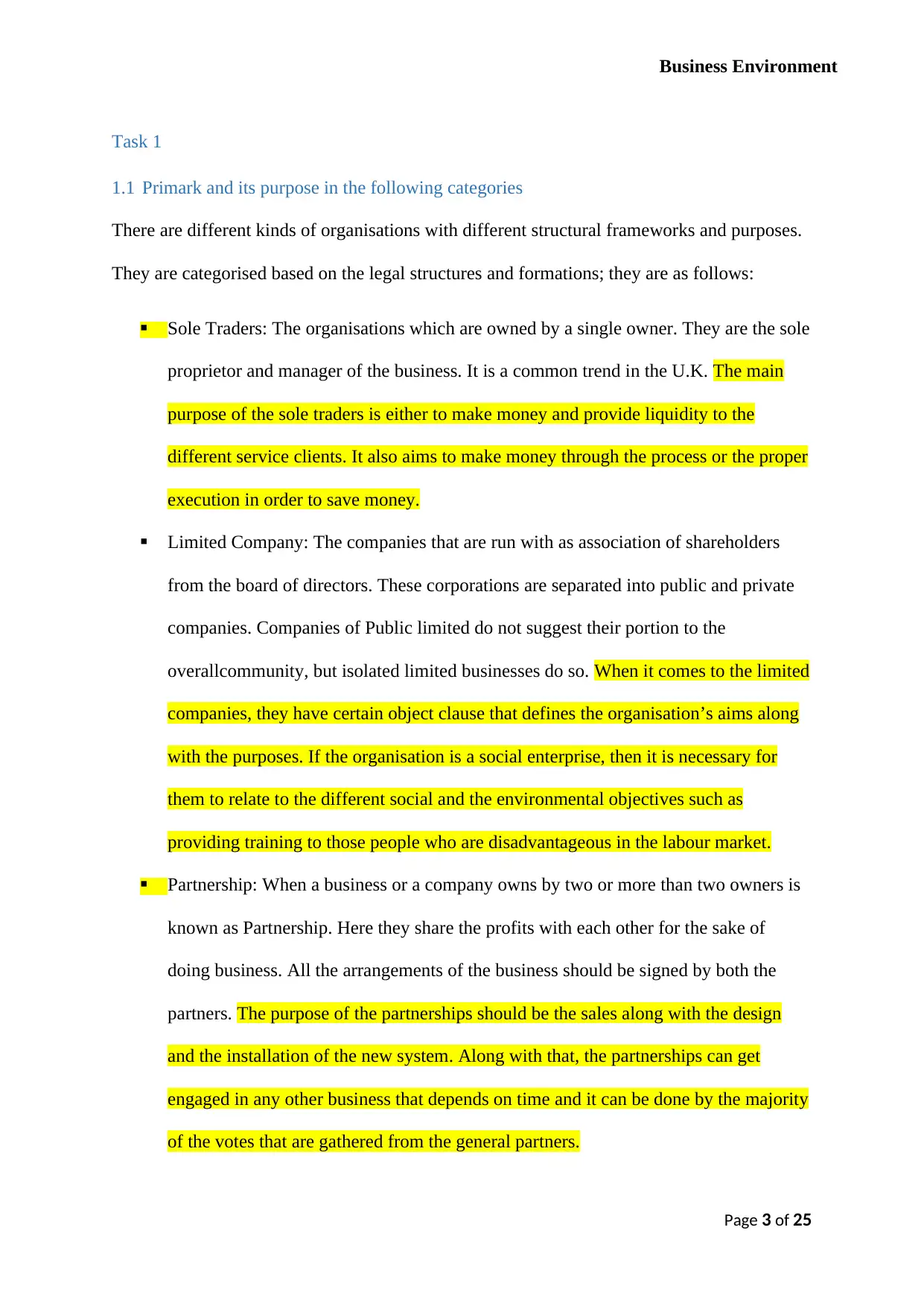
Business Environment
Task 1
1.1 Primark and its purpose in the following categories
There are different kinds of organisations with different structural frameworks and purposes.
They are categorised based on the legal structures and formations; they are as follows:
Sole Traders: The organisations which are owned by a single owner. They are the sole
proprietor and manager of the business. It is a common trend in the U.K. The main
purpose of the sole traders is either to make money and provide liquidity to the
different service clients. It also aims to make money through the process or the proper
execution in order to save money.
Limited Company: The companies that are run with as association of shareholders
from the board of directors. These corporations are separated into public and private
companies. Companies of Public limited do not suggest their portion to the
overallcommunity, but isolated limited businesses do so. When it comes to the limited
companies, they have certain object clause that defines the organisation’s aims along
with the purposes. If the organisation is a social enterprise, then it is necessary for
them to relate to the different social and the environmental objectives such as
providing training to those people who are disadvantageous in the labour market.
Partnership: When a business or a company owns by two or more than two owners is
known as Partnership. Here they share the profits with each other for the sake of
doing business. All the arrangements of the business should be signed by both the
partners. The purpose of the partnerships should be the sales along with the design
and the installation of the new system. Along with that, the partnerships can get
engaged in any other business that depends on time and it can be done by the majority
of the votes that are gathered from the general partners.
Page 3 of 25
Task 1
1.1 Primark and its purpose in the following categories
There are different kinds of organisations with different structural frameworks and purposes.
They are categorised based on the legal structures and formations; they are as follows:
Sole Traders: The organisations which are owned by a single owner. They are the sole
proprietor and manager of the business. It is a common trend in the U.K. The main
purpose of the sole traders is either to make money and provide liquidity to the
different service clients. It also aims to make money through the process or the proper
execution in order to save money.
Limited Company: The companies that are run with as association of shareholders
from the board of directors. These corporations are separated into public and private
companies. Companies of Public limited do not suggest their portion to the
overallcommunity, but isolated limited businesses do so. When it comes to the limited
companies, they have certain object clause that defines the organisation’s aims along
with the purposes. If the organisation is a social enterprise, then it is necessary for
them to relate to the different social and the environmental objectives such as
providing training to those people who are disadvantageous in the labour market.
Partnership: When a business or a company owns by two or more than two owners is
known as Partnership. Here they share the profits with each other for the sake of
doing business. All the arrangements of the business should be signed by both the
partners. The purpose of the partnerships should be the sales along with the design
and the installation of the new system. Along with that, the partnerships can get
engaged in any other business that depends on time and it can be done by the majority
of the votes that are gathered from the general partners.
Page 3 of 25
⊘ This is a preview!⊘
Do you want full access?
Subscribe today to unlock all pages.

Trusted by 1+ million students worldwide
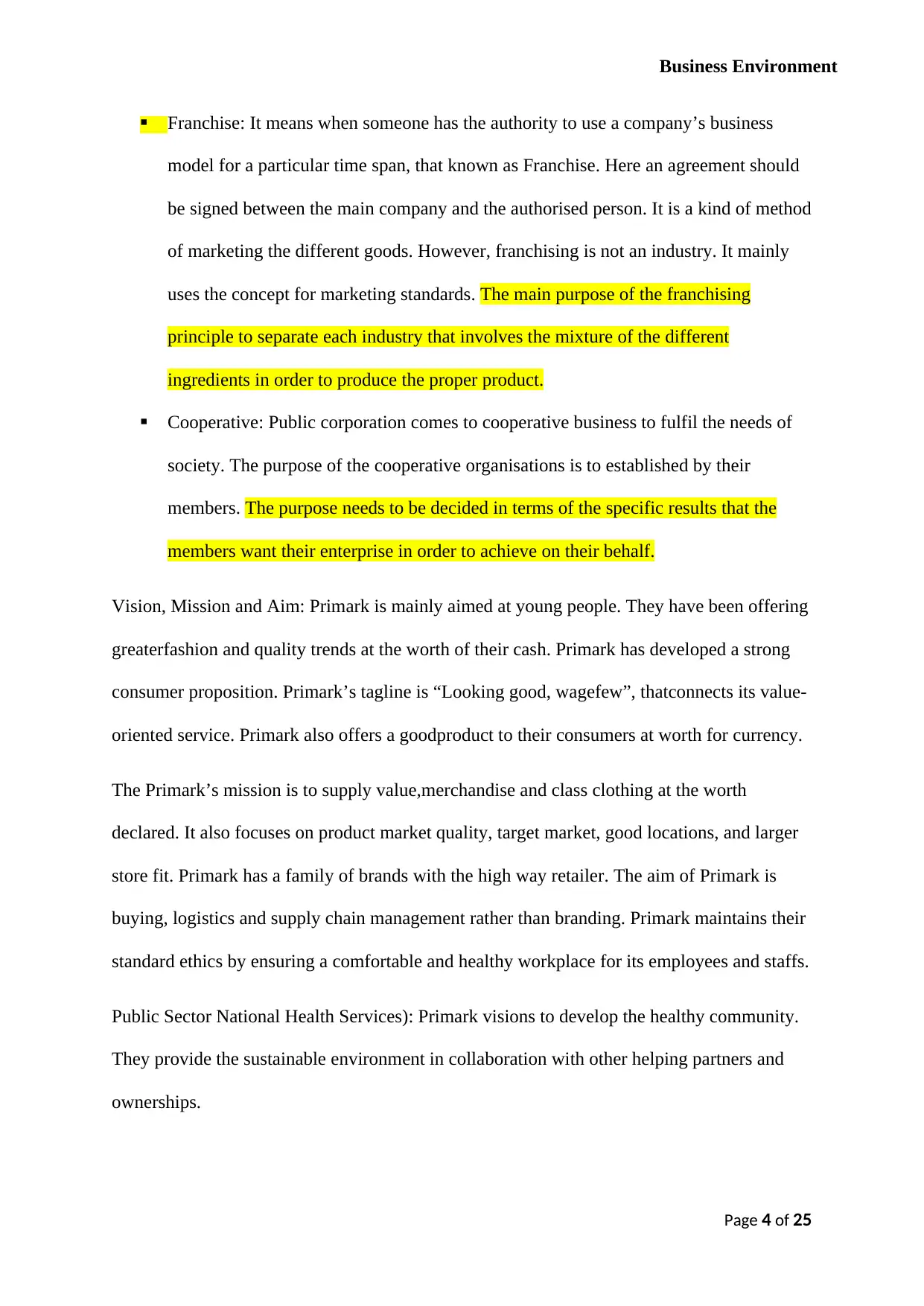
Business Environment
Franchise: It means when someone has the authority to use a company’s business
model for a particular time span, that known as Franchise. Here an agreement should
be signed between the main company and the authorised person. It is a kind of method
of marketing the different goods. However, franchising is not an industry. It mainly
uses the concept for marketing standards. The main purpose of the franchising
principle to separate each industry that involves the mixture of the different
ingredients in order to produce the proper product.
Cooperative: Public corporation comes to cooperative business to fulfil the needs of
society. The purpose of the cooperative organisations is to established by their
members. The purpose needs to be decided in terms of the specific results that the
members want their enterprise in order to achieve on their behalf.
Vision, Mission and Aim: Primark is mainly aimed at young people. They have been offering
greaterfashion and quality trends at the worth of their cash. Primark has developed a strong
consumer proposition. Primark’s tagline is “Looking good, wagefew”, thatconnects its value-
oriented service. Primark also offers a goodproduct to their consumers at worth for currency.
The Primark’s mission is to supply value,merchandise and class clothing at the worth
declared. It also focuses on product market quality, target market, good locations, and larger
store fit. Primark has a family of brands with the high way retailer. The aim of Primark is
buying, logistics and supply chain management rather than branding. Primark maintains their
standard ethics by ensuring a comfortable and healthy workplace for its employees and staffs.
Public Sector National Health Services): Primark visions to develop the healthy community.
They provide the sustainable environment in collaboration with other helping partners and
ownerships.
Page 4 of 25
Franchise: It means when someone has the authority to use a company’s business
model for a particular time span, that known as Franchise. Here an agreement should
be signed between the main company and the authorised person. It is a kind of method
of marketing the different goods. However, franchising is not an industry. It mainly
uses the concept for marketing standards. The main purpose of the franchising
principle to separate each industry that involves the mixture of the different
ingredients in order to produce the proper product.
Cooperative: Public corporation comes to cooperative business to fulfil the needs of
society. The purpose of the cooperative organisations is to established by their
members. The purpose needs to be decided in terms of the specific results that the
members want their enterprise in order to achieve on their behalf.
Vision, Mission and Aim: Primark is mainly aimed at young people. They have been offering
greaterfashion and quality trends at the worth of their cash. Primark has developed a strong
consumer proposition. Primark’s tagline is “Looking good, wagefew”, thatconnects its value-
oriented service. Primark also offers a goodproduct to their consumers at worth for currency.
The Primark’s mission is to supply value,merchandise and class clothing at the worth
declared. It also focuses on product market quality, target market, good locations, and larger
store fit. Primark has a family of brands with the high way retailer. The aim of Primark is
buying, logistics and supply chain management rather than branding. Primark maintains their
standard ethics by ensuring a comfortable and healthy workplace for its employees and staffs.
Public Sector National Health Services): Primark visions to develop the healthy community.
They provide the sustainable environment in collaboration with other helping partners and
ownerships.
Page 4 of 25
Paraphrase This Document
Need a fresh take? Get an instant paraphrase of this document with our AI Paraphraser
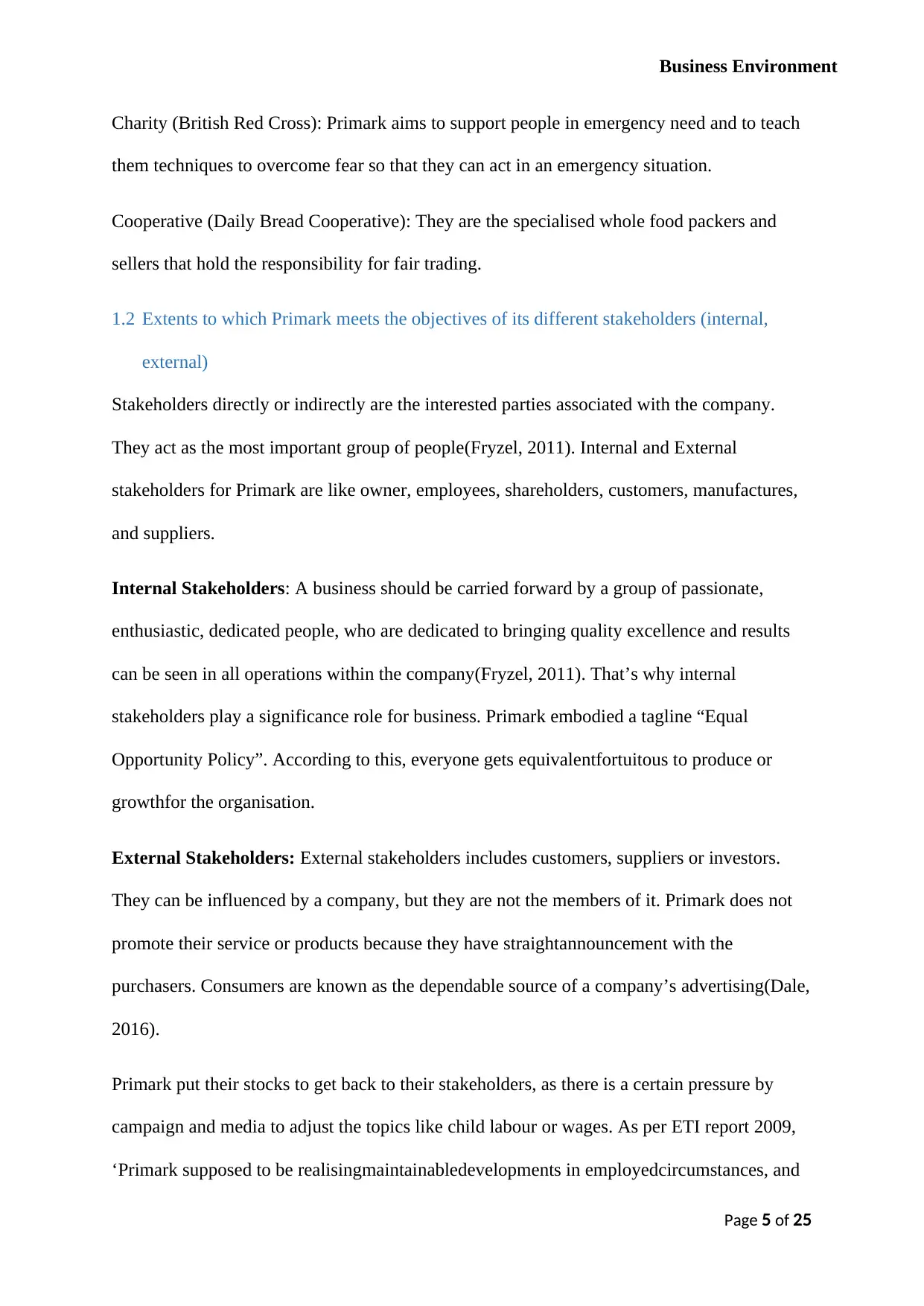
Business Environment
Charity (British Red Cross): Primark aims to support people in emergency need and to teach
them techniques to overcome fear so that they can act in an emergency situation.
Cooperative (Daily Bread Cooperative): They are the specialised whole food packers and
sellers that hold the responsibility for fair trading.
1.2 Extents to which Primark meets the objectives of its different stakeholders (internal,
external)
Stakeholders directly or indirectly are the interested parties associated with the company.
They act as the most important group of people(Fryzel, 2011). Internal and External
stakeholders for Primark are like owner, employees, shareholders, customers, manufactures,
and suppliers.
Internal Stakeholders: A business should be carried forward by a group of passionate,
enthusiastic, dedicated people, who are dedicated to bringing quality excellence and results
can be seen in all operations within the company(Fryzel, 2011). That’s why internal
stakeholders play a significance role for business. Primark embodied a tagline “Equal
Opportunity Policy”. According to this, everyone gets equivalentfortuitous to produce or
growthfor the organisation.
External Stakeholders: External stakeholders includes customers, suppliers or investors.
They can be influenced by a company, but they are not the members of it. Primark does not
promote their service or products because they have straightannouncement with the
purchasers. Consumers are known as the dependable source of a company’s advertising(Dale,
2016).
Primark put their stocks to get back to their stakeholders, as there is a certain pressure by
campaign and media to adjust the topics like child labour or wages. As per ETI report 2009,
‘Primark supposed to be realisingmaintainabledevelopments in employedcircumstances, and
Page 5 of 25
Charity (British Red Cross): Primark aims to support people in emergency need and to teach
them techniques to overcome fear so that they can act in an emergency situation.
Cooperative (Daily Bread Cooperative): They are the specialised whole food packers and
sellers that hold the responsibility for fair trading.
1.2 Extents to which Primark meets the objectives of its different stakeholders (internal,
external)
Stakeholders directly or indirectly are the interested parties associated with the company.
They act as the most important group of people(Fryzel, 2011). Internal and External
stakeholders for Primark are like owner, employees, shareholders, customers, manufactures,
and suppliers.
Internal Stakeholders: A business should be carried forward by a group of passionate,
enthusiastic, dedicated people, who are dedicated to bringing quality excellence and results
can be seen in all operations within the company(Fryzel, 2011). That’s why internal
stakeholders play a significance role for business. Primark embodied a tagline “Equal
Opportunity Policy”. According to this, everyone gets equivalentfortuitous to produce or
growthfor the organisation.
External Stakeholders: External stakeholders includes customers, suppliers or investors.
They can be influenced by a company, but they are not the members of it. Primark does not
promote their service or products because they have straightannouncement with the
purchasers. Consumers are known as the dependable source of a company’s advertising(Dale,
2016).
Primark put their stocks to get back to their stakeholders, as there is a certain pressure by
campaign and media to adjust the topics like child labour or wages. As per ETI report 2009,
‘Primark supposed to be realisingmaintainabledevelopments in employedcircumstances, and
Page 5 of 25
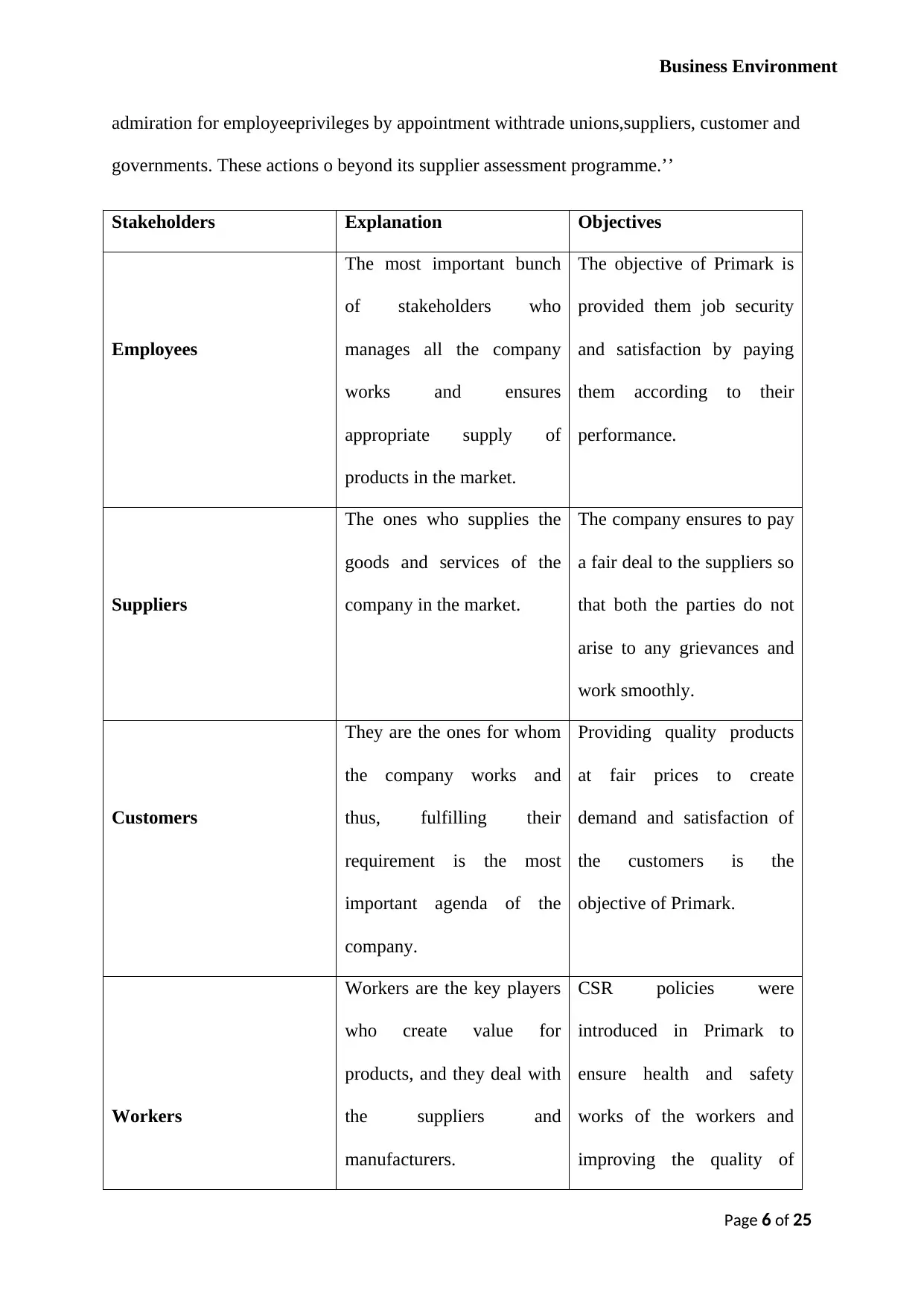
Business Environment
admiration for employeeprivileges by appointment withtrade unions,suppliers, customer and
governments. These actions o beyond its supplier assessment programme.’’
Stakeholders Explanation Objectives
Employees
The most important bunch
of stakeholders who
manages all the company
works and ensures
appropriate supply of
products in the market.
The objective of Primark is
provided them job security
and satisfaction by paying
them according to their
performance.
Suppliers
The ones who supplies the
goods and services of the
company in the market.
The company ensures to pay
a fair deal to the suppliers so
that both the parties do not
arise to any grievances and
work smoothly.
Customers
They are the ones for whom
the company works and
thus, fulfilling their
requirement is the most
important agenda of the
company.
Providing quality products
at fair prices to create
demand and satisfaction of
the customers is the
objective of Primark.
Workers
Workers are the key players
who create value for
products, and they deal with
the suppliers and
manufacturers.
CSR policies were
introduced in Primark to
ensure health and safety
works of the workers and
improving the quality of
Page 6 of 25
admiration for employeeprivileges by appointment withtrade unions,suppliers, customer and
governments. These actions o beyond its supplier assessment programme.’’
Stakeholders Explanation Objectives
Employees
The most important bunch
of stakeholders who
manages all the company
works and ensures
appropriate supply of
products in the market.
The objective of Primark is
provided them job security
and satisfaction by paying
them according to their
performance.
Suppliers
The ones who supplies the
goods and services of the
company in the market.
The company ensures to pay
a fair deal to the suppliers so
that both the parties do not
arise to any grievances and
work smoothly.
Customers
They are the ones for whom
the company works and
thus, fulfilling their
requirement is the most
important agenda of the
company.
Providing quality products
at fair prices to create
demand and satisfaction of
the customers is the
objective of Primark.
Workers
Workers are the key players
who create value for
products, and they deal with
the suppliers and
manufacturers.
CSR policies were
introduced in Primark to
ensure health and safety
works of the workers and
improving the quality of
Page 6 of 25
⊘ This is a preview!⊘
Do you want full access?
Subscribe today to unlock all pages.

Trusted by 1+ million students worldwide
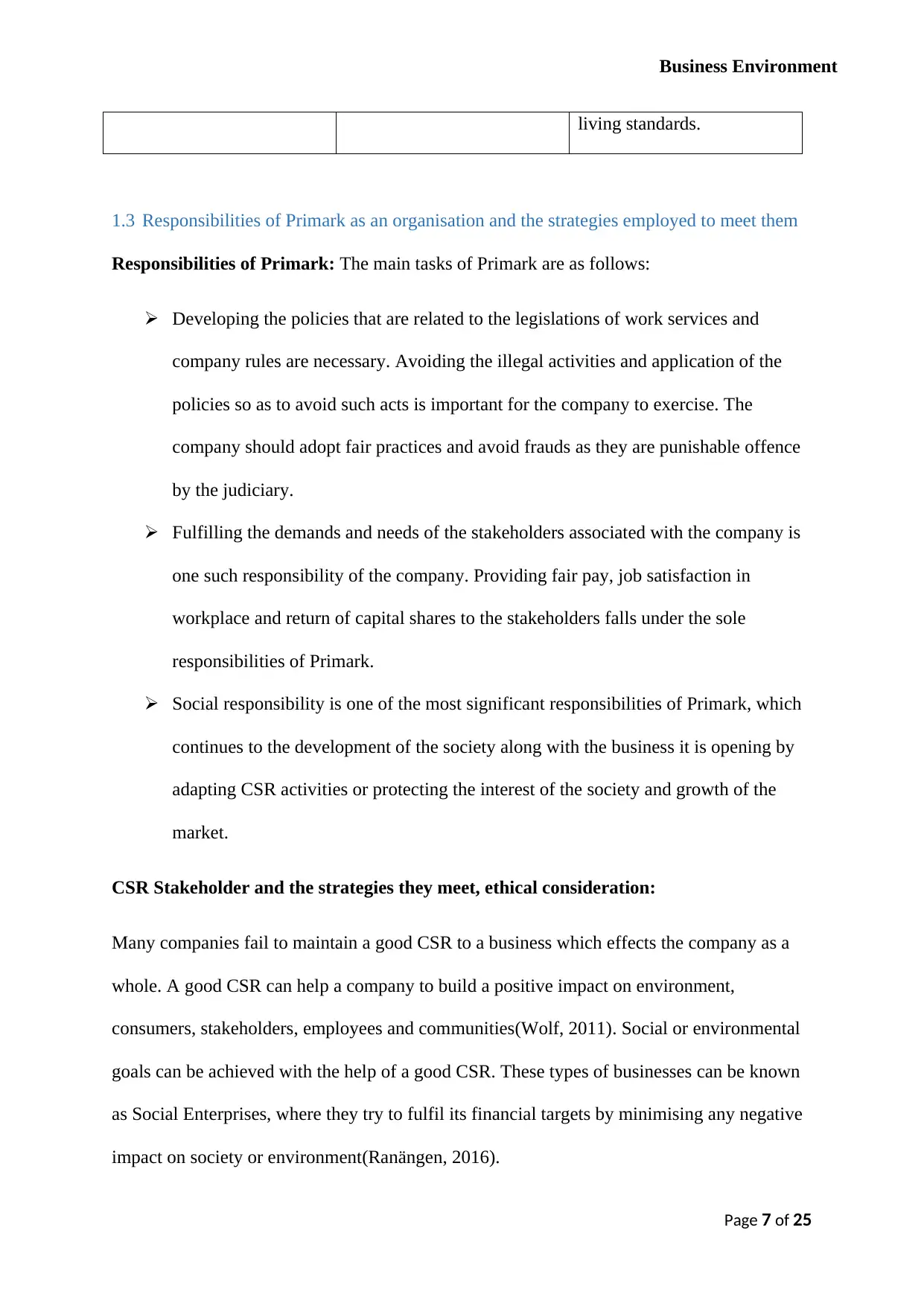
Business Environment
living standards.
1.3 Responsibilities of Primark as an organisation and the strategies employed to meet them
Responsibilities of Primark: The main tasks of Primark are as follows:
Developing the policies that are related to the legislations of work services and
company rules are necessary. Avoiding the illegal activities and application of the
policies so as to avoid such acts is important for the company to exercise. The
company should adopt fair practices and avoid frauds as they are punishable offence
by the judiciary.
Fulfilling the demands and needs of the stakeholders associated with the company is
one such responsibility of the company. Providing fair pay, job satisfaction in
workplace and return of capital shares to the stakeholders falls under the sole
responsibilities of Primark.
Social responsibility is one of the most significant responsibilities of Primark, which
continues to the development of the society along with the business it is opening by
adapting CSR activities or protecting the interest of the society and growth of the
market.
CSR Stakeholder and the strategies they meet, ethical consideration:
Many companies fail to maintain a good CSR to a business which effects the company as a
whole. A good CSR can help a company to build a positive impact on environment,
consumers, stakeholders, employees and communities(Wolf, 2011). Social or environmental
goals can be achieved with the help of a good CSR. These types of businesses can be known
as Social Enterprises, where they try to fulfil its financial targets by minimising any negative
impact on society or environment(Ranängen, 2016).
Page 7 of 25
living standards.
1.3 Responsibilities of Primark as an organisation and the strategies employed to meet them
Responsibilities of Primark: The main tasks of Primark are as follows:
Developing the policies that are related to the legislations of work services and
company rules are necessary. Avoiding the illegal activities and application of the
policies so as to avoid such acts is important for the company to exercise. The
company should adopt fair practices and avoid frauds as they are punishable offence
by the judiciary.
Fulfilling the demands and needs of the stakeholders associated with the company is
one such responsibility of the company. Providing fair pay, job satisfaction in
workplace and return of capital shares to the stakeholders falls under the sole
responsibilities of Primark.
Social responsibility is one of the most significant responsibilities of Primark, which
continues to the development of the society along with the business it is opening by
adapting CSR activities or protecting the interest of the society and growth of the
market.
CSR Stakeholder and the strategies they meet, ethical consideration:
Many companies fail to maintain a good CSR to a business which effects the company as a
whole. A good CSR can help a company to build a positive impact on environment,
consumers, stakeholders, employees and communities(Wolf, 2011). Social or environmental
goals can be achieved with the help of a good CSR. These types of businesses can be known
as Social Enterprises, where they try to fulfil its financial targets by minimising any negative
impact on society or environment(Ranängen, 2016).
Page 7 of 25
Paraphrase This Document
Need a fresh take? Get an instant paraphrase of this document with our AI Paraphraser
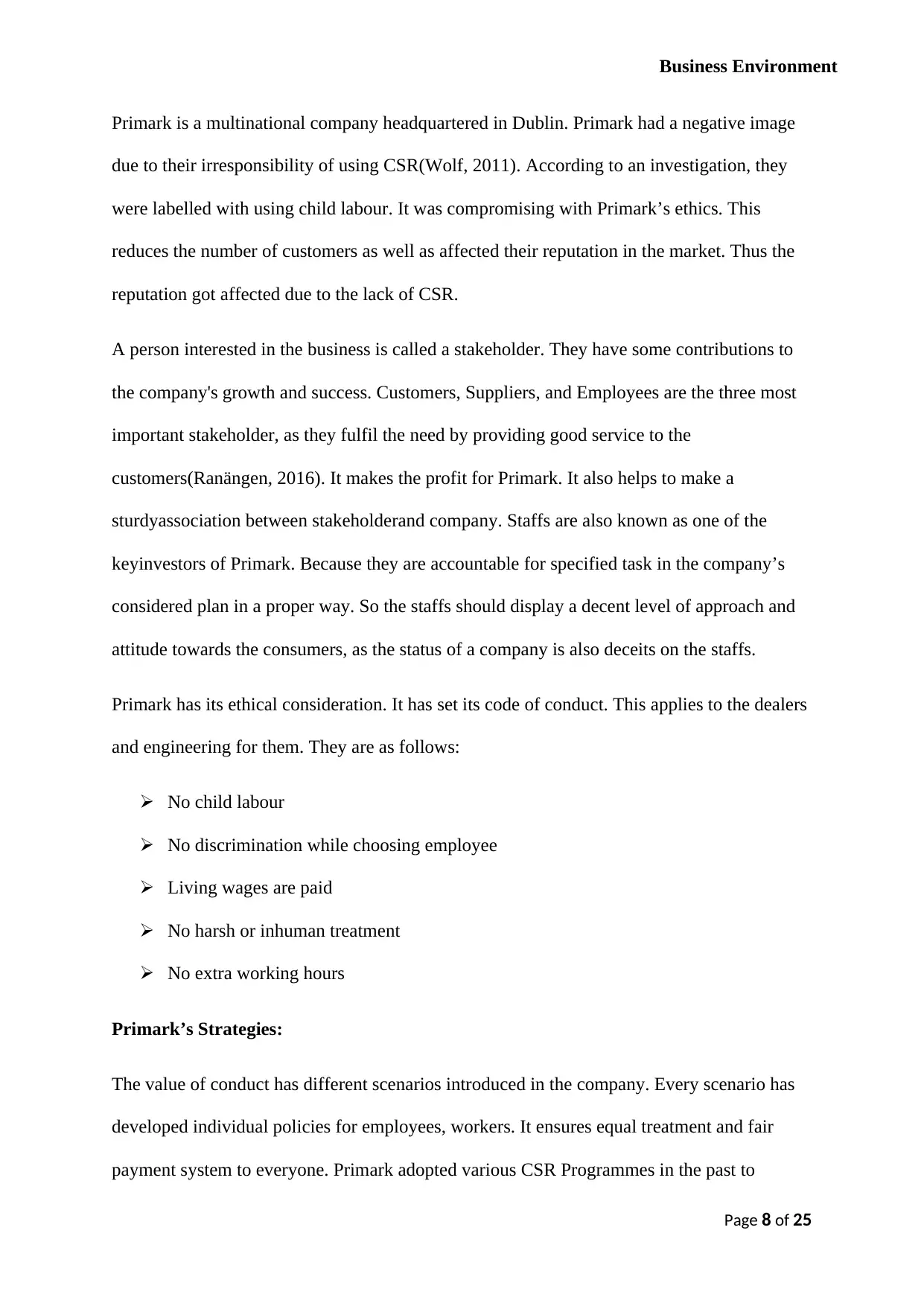
Business Environment
Primark is a multinational company headquartered in Dublin. Primark had a negative image
due to their irresponsibility of using CSR(Wolf, 2011). According to an investigation, they
were labelled with using child labour. It was compromising with Primark’s ethics. This
reduces the number of customers as well as affected their reputation in the market. Thus the
reputation got affected due to the lack of CSR.
A person interested in the business is called a stakeholder. They have some contributions to
the company's growth and success. Customers, Suppliers, and Employees are the three most
important stakeholder, as they fulfil the need by providing good service to the
customers(Ranängen, 2016). It makes the profit for Primark. It also helps to make a
sturdyassociation between stakeholderand company. Staffs are also known as one of the
keyinvestors of Primark. Because they are accountable for specified task in the company’s
considered plan in a proper way. So the staffs should display a decent level of approach and
attitude towards the consumers, as the status of a company is also deceits on the staffs.
Primark has its ethical consideration. It has set its code of conduct. This applies to the dealers
and engineering for them. They are as follows:
No child labour
No discrimination while choosing employee
Living wages are paid
No harsh or inhuman treatment
No extra working hours
Primark’s Strategies:
The value of conduct has different scenarios introduced in the company. Every scenario has
developed individual policies for employees, workers. It ensures equal treatment and fair
payment system to everyone. Primark adopted various CSR Programmes in the past to
Page 8 of 25
Primark is a multinational company headquartered in Dublin. Primark had a negative image
due to their irresponsibility of using CSR(Wolf, 2011). According to an investigation, they
were labelled with using child labour. It was compromising with Primark’s ethics. This
reduces the number of customers as well as affected their reputation in the market. Thus the
reputation got affected due to the lack of CSR.
A person interested in the business is called a stakeholder. They have some contributions to
the company's growth and success. Customers, Suppliers, and Employees are the three most
important stakeholder, as they fulfil the need by providing good service to the
customers(Ranängen, 2016). It makes the profit for Primark. It also helps to make a
sturdyassociation between stakeholderand company. Staffs are also known as one of the
keyinvestors of Primark. Because they are accountable for specified task in the company’s
considered plan in a proper way. So the staffs should display a decent level of approach and
attitude towards the consumers, as the status of a company is also deceits on the staffs.
Primark has its ethical consideration. It has set its code of conduct. This applies to the dealers
and engineering for them. They are as follows:
No child labour
No discrimination while choosing employee
Living wages are paid
No harsh or inhuman treatment
No extra working hours
Primark’s Strategies:
The value of conduct has different scenarios introduced in the company. Every scenario has
developed individual policies for employees, workers. It ensures equal treatment and fair
payment system to everyone. Primark adopted various CSR Programmes in the past to
Page 8 of 25
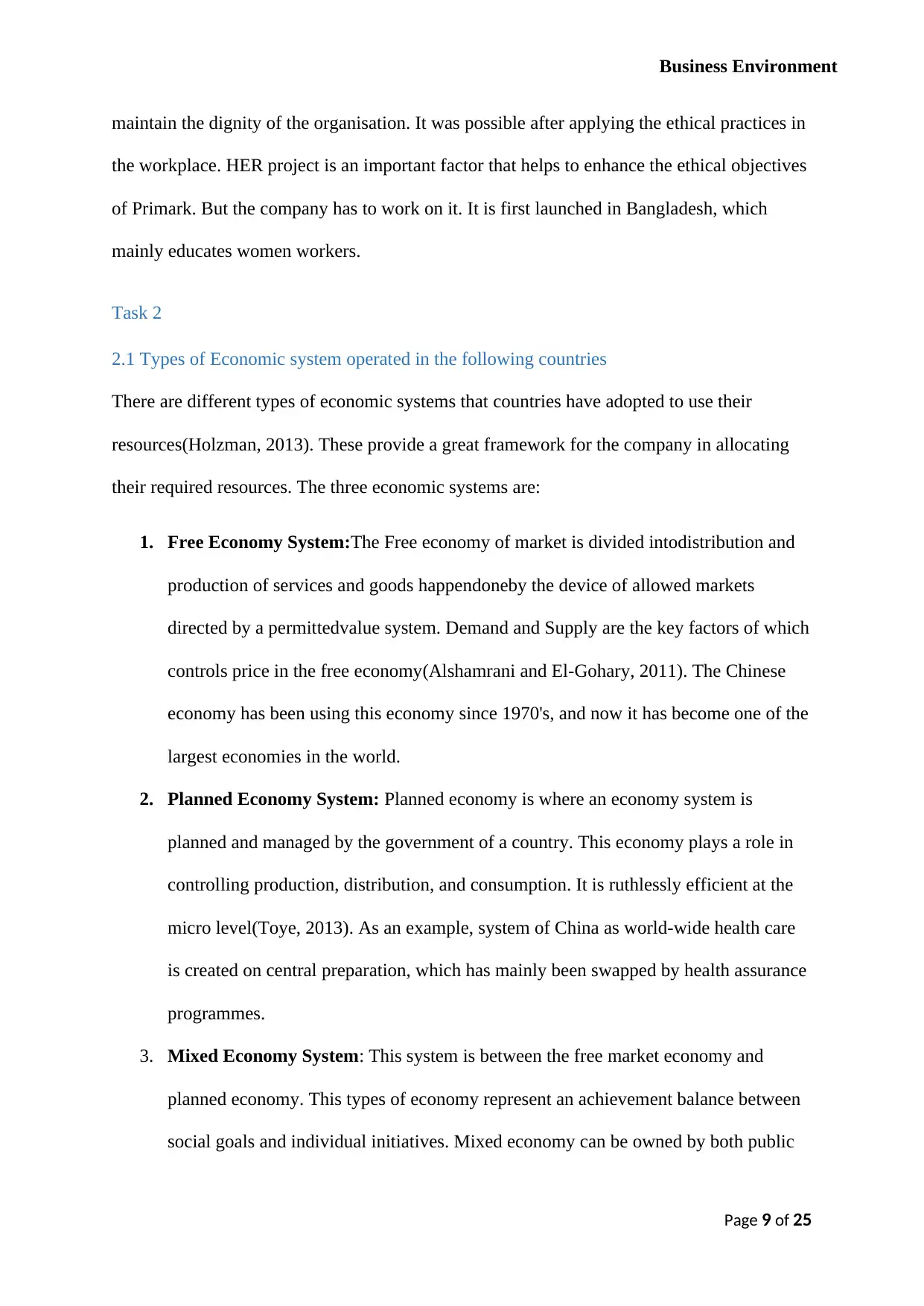
Business Environment
maintain the dignity of the organisation. It was possible after applying the ethical practices in
the workplace. HER project is an important factor that helps to enhance the ethical objectives
of Primark. But the company has to work on it. It is first launched in Bangladesh, which
mainly educates women workers.
Task 2
2.1 Types of Economic system operated in the following countries
There are different types of economic systems that countries have adopted to use their
resources(Holzman, 2013). These provide a great framework for the company in allocating
their required resources. The three economic systems are:
1. Free Economy System:The Free economy of market is divided intodistribution and
production of services and goods happendoneby the device of allowed markets
directed by a permittedvalue system. Demand and Supply are the key factors of which
controls price in the free economy(Alshamrani and El-Gohary, 2011). The Chinese
economy has been using this economy since 1970's, and now it has become one of the
largest economies in the world.
2. Planned Economy System: Planned economy is where an economy system is
planned and managed by the government of a country. This economy plays a role in
controlling production, distribution, and consumption. It is ruthlessly efficient at the
micro level(Toye, 2013). As an example, system of China as world-wide health care
is created on central preparation, which has mainly been swapped by health assurance
programmes.
3. Mixed Economy System: This system is between the free market economy and
planned economy. This types of economy represent an achievement balance between
social goals and individual initiatives. Mixed economy can be owned by both public
Page 9 of 25
maintain the dignity of the organisation. It was possible after applying the ethical practices in
the workplace. HER project is an important factor that helps to enhance the ethical objectives
of Primark. But the company has to work on it. It is first launched in Bangladesh, which
mainly educates women workers.
Task 2
2.1 Types of Economic system operated in the following countries
There are different types of economic systems that countries have adopted to use their
resources(Holzman, 2013). These provide a great framework for the company in allocating
their required resources. The three economic systems are:
1. Free Economy System:The Free economy of market is divided intodistribution and
production of services and goods happendoneby the device of allowed markets
directed by a permittedvalue system. Demand and Supply are the key factors of which
controls price in the free economy(Alshamrani and El-Gohary, 2011). The Chinese
economy has been using this economy since 1970's, and now it has become one of the
largest economies in the world.
2. Planned Economy System: Planned economy is where an economy system is
planned and managed by the government of a country. This economy plays a role in
controlling production, distribution, and consumption. It is ruthlessly efficient at the
micro level(Toye, 2013). As an example, system of China as world-wide health care
is created on central preparation, which has mainly been swapped by health assurance
programmes.
3. Mixed Economy System: This system is between the free market economy and
planned economy. This types of economy represent an achievement balance between
social goals and individual initiatives. Mixed economy can be owned by both public
Page 9 of 25
⊘ This is a preview!⊘
Do you want full access?
Subscribe today to unlock all pages.

Trusted by 1+ million students worldwide
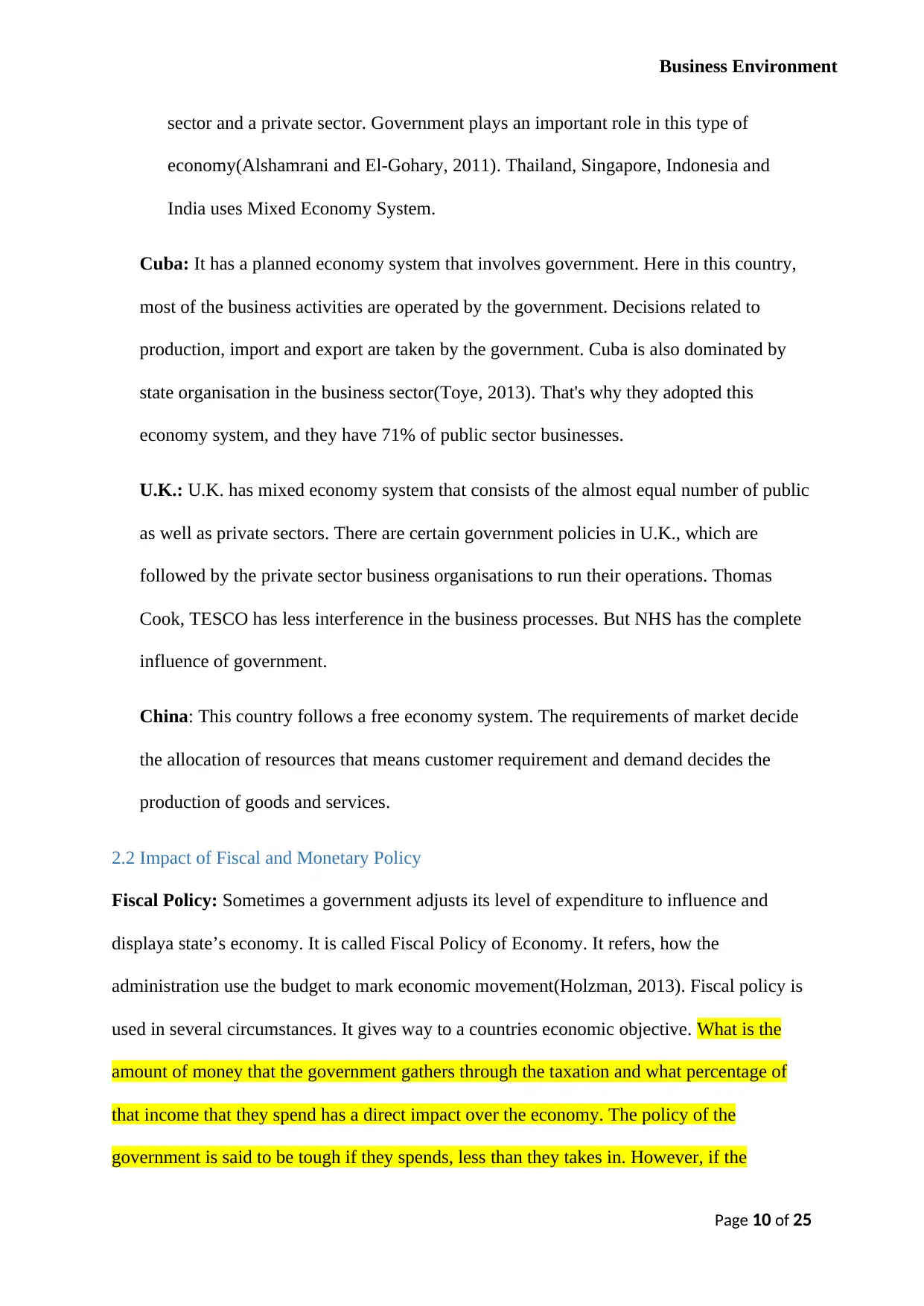
Business Environment
sector and a private sector. Government plays an important role in this type of
economy(Alshamrani and El-Gohary, 2011). Thailand, Singapore, Indonesia and
India uses Mixed Economy System.
Cuba: It has a planned economy system that involves government. Here in this country,
most of the business activities are operated by the government. Decisions related to
production, import and export are taken by the government. Cuba is also dominated by
state organisation in the business sector(Toye, 2013). That's why they adopted this
economy system, and they have 71% of public sector businesses.
U.K.: U.K. has mixed economy system that consists of the almost equal number of public
as well as private sectors. There are certain government policies in U.K., which are
followed by the private sector business organisations to run their operations. Thomas
Cook, TESCO has less interference in the business processes. But NHS has the complete
influence of government.
China: This country follows a free economy system. The requirements of market decide
the allocation of resources that means customer requirement and demand decides the
production of goods and services.
2.2 Impact of Fiscal and Monetary Policy
Fiscal Policy: Sometimes a government adjusts its level of expenditure to influence and
displaya state’s economy. It is called Fiscal Policy of Economy. It refers, how the
administration use the budget to mark economic movement(Holzman, 2013). Fiscal policy is
used in several circumstances. It gives way to a countries economic objective. What is the
amount of money that the government gathers through the taxation and what percentage of
that income that they spend has a direct impact over the economy. The policy of the
government is said to be tough if they spends, less than they takes in. However, if the
Page 10 of 25
sector and a private sector. Government plays an important role in this type of
economy(Alshamrani and El-Gohary, 2011). Thailand, Singapore, Indonesia and
India uses Mixed Economy System.
Cuba: It has a planned economy system that involves government. Here in this country,
most of the business activities are operated by the government. Decisions related to
production, import and export are taken by the government. Cuba is also dominated by
state organisation in the business sector(Toye, 2013). That's why they adopted this
economy system, and they have 71% of public sector businesses.
U.K.: U.K. has mixed economy system that consists of the almost equal number of public
as well as private sectors. There are certain government policies in U.K., which are
followed by the private sector business organisations to run their operations. Thomas
Cook, TESCO has less interference in the business processes. But NHS has the complete
influence of government.
China: This country follows a free economy system. The requirements of market decide
the allocation of resources that means customer requirement and demand decides the
production of goods and services.
2.2 Impact of Fiscal and Monetary Policy
Fiscal Policy: Sometimes a government adjusts its level of expenditure to influence and
displaya state’s economy. It is called Fiscal Policy of Economy. It refers, how the
administration use the budget to mark economic movement(Holzman, 2013). Fiscal policy is
used in several circumstances. It gives way to a countries economic objective. What is the
amount of money that the government gathers through the taxation and what percentage of
that income that they spend has a direct impact over the economy. The policy of the
government is said to be tough if they spends, less than they takes in. However, if the
Page 10 of 25
Paraphrase This Document
Need a fresh take? Get an instant paraphrase of this document with our AI Paraphraser
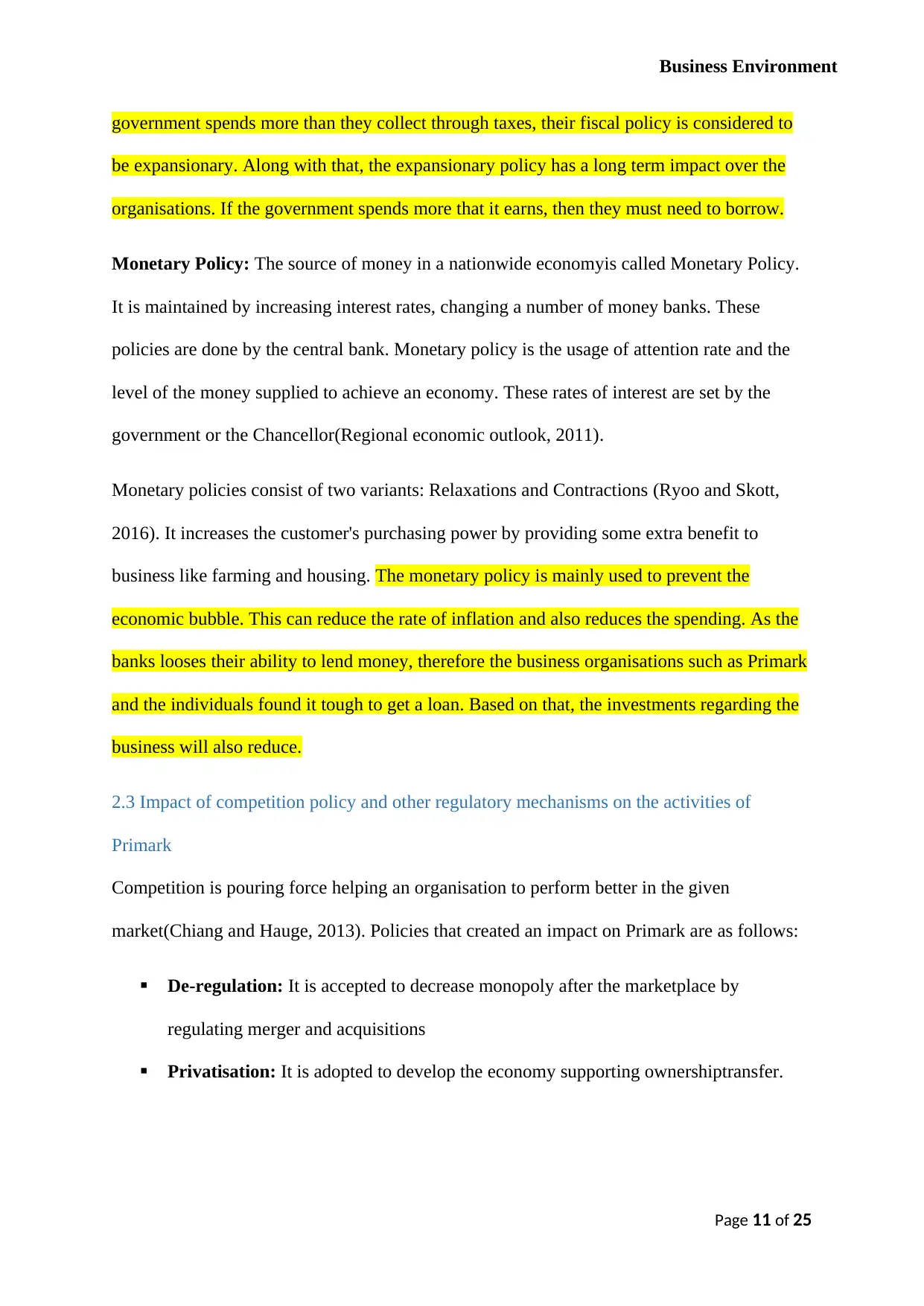
Business Environment
government spends more than they collect through taxes, their fiscal policy is considered to
be expansionary. Along with that, the expansionary policy has a long term impact over the
organisations. If the government spends more that it earns, then they must need to borrow.
Monetary Policy: The source of money in a nationwide economyis called Monetary Policy.
It is maintained by increasing interest rates, changing a number of money banks. These
policies are done by the central bank. Monetary policy is the usage of attention rate and the
level of the money supplied to achieve an economy. These rates of interest are set by the
government or the Chancellor(Regional economic outlook, 2011).
Monetary policies consist of two variants: Relaxations and Contractions (Ryoo and Skott,
2016). It increases the customer's purchasing power by providing some extra benefit to
business like farming and housing. The monetary policy is mainly used to prevent the
economic bubble. This can reduce the rate of inflation and also reduces the spending. As the
banks looses their ability to lend money, therefore the business organisations such as Primark
and the individuals found it tough to get a loan. Based on that, the investments regarding the
business will also reduce.
2.3 Impact of competition policy and other regulatory mechanisms on the activities of
Primark
Competition is pouring force helping an organisation to perform better in the given
market(Chiang and Hauge, 2013). Policies that created an impact on Primark are as follows:
De-regulation: It is accepted to decrease monopoly after the marketplace by
regulating merger and acquisitions
Privatisation: It is adopted to develop the economy supporting ownershiptransfer.
Page 11 of 25
government spends more than they collect through taxes, their fiscal policy is considered to
be expansionary. Along with that, the expansionary policy has a long term impact over the
organisations. If the government spends more that it earns, then they must need to borrow.
Monetary Policy: The source of money in a nationwide economyis called Monetary Policy.
It is maintained by increasing interest rates, changing a number of money banks. These
policies are done by the central bank. Monetary policy is the usage of attention rate and the
level of the money supplied to achieve an economy. These rates of interest are set by the
government or the Chancellor(Regional economic outlook, 2011).
Monetary policies consist of two variants: Relaxations and Contractions (Ryoo and Skott,
2016). It increases the customer's purchasing power by providing some extra benefit to
business like farming and housing. The monetary policy is mainly used to prevent the
economic bubble. This can reduce the rate of inflation and also reduces the spending. As the
banks looses their ability to lend money, therefore the business organisations such as Primark
and the individuals found it tough to get a loan. Based on that, the investments regarding the
business will also reduce.
2.3 Impact of competition policy and other regulatory mechanisms on the activities of
Primark
Competition is pouring force helping an organisation to perform better in the given
market(Chiang and Hauge, 2013). Policies that created an impact on Primark are as follows:
De-regulation: It is accepted to decrease monopoly after the marketplace by
regulating merger and acquisitions
Privatisation: It is adopted to develop the economy supporting ownershiptransfer.
Page 11 of 25
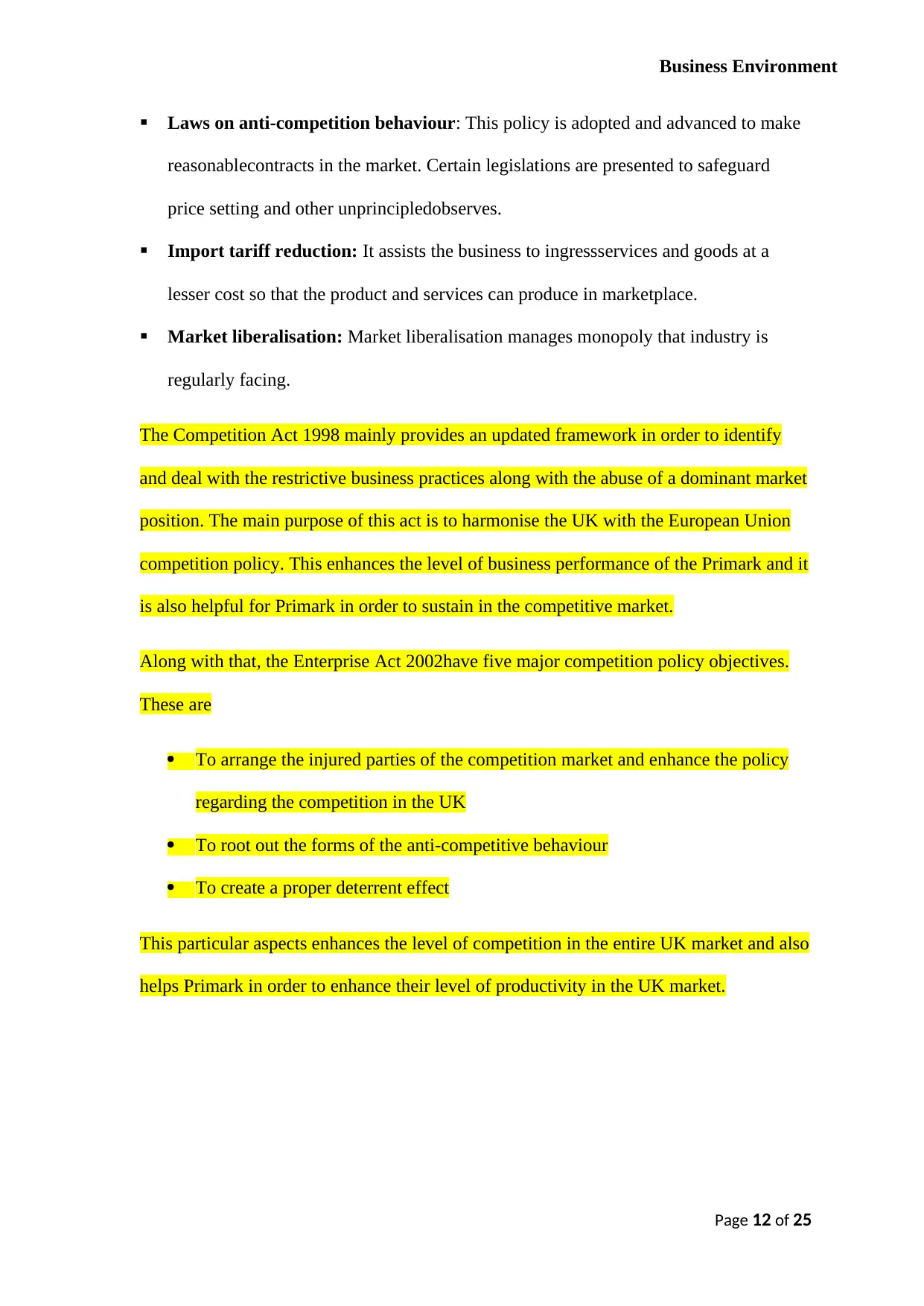
Business Environment
Laws on anti-competition behaviour: This policy is adopted and advanced to make
reasonablecontracts in the market. Certain legislations are presented to safeguard
price setting and other unprincipledobserves.
Import tariff reduction: It assists the business to ingressservices and goods at a
lesser cost so that the product and services can produce in marketplace.
Market liberalisation: Market liberalisation manages monopoly that industry is
regularly facing.
The Competition Act 1998 mainly provides an updated framework in order to identify
and deal with the restrictive business practices along with the abuse of a dominant market
position. The main purpose of this act is to harmonise the UK with the European Union
competition policy. This enhances the level of business performance of the Primark and it
is also helpful for Primark in order to sustain in the competitive market.
Along with that, the Enterprise Act 2002have five major competition policy objectives.
These are
To arrange the injured parties of the competition market and enhance the policy
regarding the competition in the UK
To root out the forms of the anti-competitive behaviour
To create a proper deterrent effect
This particular aspects enhances the level of competition in the entire UK market and also
helps Primark in order to enhance their level of productivity in the UK market.
Page 12 of 25
Laws on anti-competition behaviour: This policy is adopted and advanced to make
reasonablecontracts in the market. Certain legislations are presented to safeguard
price setting and other unprincipledobserves.
Import tariff reduction: It assists the business to ingressservices and goods at a
lesser cost so that the product and services can produce in marketplace.
Market liberalisation: Market liberalisation manages monopoly that industry is
regularly facing.
The Competition Act 1998 mainly provides an updated framework in order to identify
and deal with the restrictive business practices along with the abuse of a dominant market
position. The main purpose of this act is to harmonise the UK with the European Union
competition policy. This enhances the level of business performance of the Primark and it
is also helpful for Primark in order to sustain in the competitive market.
Along with that, the Enterprise Act 2002have five major competition policy objectives.
These are
To arrange the injured parties of the competition market and enhance the policy
regarding the competition in the UK
To root out the forms of the anti-competitive behaviour
To create a proper deterrent effect
This particular aspects enhances the level of competition in the entire UK market and also
helps Primark in order to enhance their level of productivity in the UK market.
Page 12 of 25
⊘ This is a preview!⊘
Do you want full access?
Subscribe today to unlock all pages.

Trusted by 1+ million students worldwide
1 out of 24
Related Documents
Your All-in-One AI-Powered Toolkit for Academic Success.
+13062052269
info@desklib.com
Available 24*7 on WhatsApp / Email
![[object Object]](/_next/static/media/star-bottom.7253800d.svg)
Unlock your academic potential
Copyright © 2020–2025 A2Z Services. All Rights Reserved. Developed and managed by ZUCOL.




